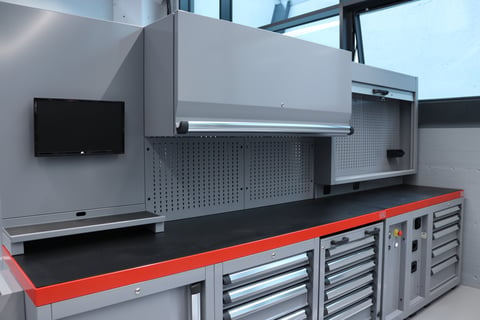 The motorbike workbench is a very important support point for a mechanic.
The motorbike workbench is a very important support point for a mechanic.
For this reason, it must be managed in an optimum manner to ensure the maximum efficiency of the operations.
We will talk about this in the article.
Keep reading to find out more!
The importance of the motorbike workbench
In an efficient workshop, after a thorough design phase, the position of the motorbike workbench is precisely determined in relation to the concrete requirements of the mechanics and their work.
Indeed the workbench, along with the lifting platform, represents the linchpin of the majority of the work, and must therefore be optimised and managed in order to reach the highest levels of efficiency and to improve performance.
To understand where and whether there is scope for improvement with your workshop's workbenches, you should ask yourself this strategic question:
Is the organisation of the workbenches the best it can be? Does it reflect the practical requirements of the mechanics?
Is there sufficient space to perform all services in a neat, organised manner while maintaining a good level of cleanliness?
Where are the most important tools for completing the works positioned?
Through these considerations, we can identify some key aspects to keep in mind with regard to a workbench:
- The position
- The quality of the materials
- The presence of dedicated storage compartments
- Alignment with needs
We’ll try to explain better.
Managing the motorbike workbench
Getting back to the items we have just listed, the position of the bench is the first aspect to take into consideration when deciding to renovate or build a workshop from scratch, and it is defined after a dedicated design phase and an analysis of the workflows.
Where can I position the workbench in a strategic manner for the mechanic?
Would installing it near the vehicle lift be advantageous?
How would creating workstations with shared benches or workstations dedicated to specific jobs improve the performance of the workshop?

The quality of the materials is equally important for an efficient workbench.
What are the simplest materials to clean and which can help me keep the workstation tidy, while at the same time ensuring a long lifetime for the product?
The materials can have a significant influence on the lifespan of a product – a long-lasting product can be considered a long-term investment.
Once again with the goal of keeping the workstation tidy, the ideal motorbike workbench should have a series of spaces and compartments dedicated to the storage of tools and equipment which can help improve the work.
Where can fairings or other large parts removed from vehicles be positioned, for example? Or where can the tools be put away neatly once the work is complete?
As a general rule, a workbench must meet the concrete production requirements of the workshop, and the practical requirements of the mechanics.
What is best suited for one specific context may not be suitable for another situation.
KIRO's experts carry out an attentive analysis on a case-by-case basis, with an initial very thorough design phase performed alongside the workshop staff in order to identify the requirements which will serve as guidelines for the complete development of the entire workshop design.
Efficient workbench management in the workshop can represent a major competitive advantage, with positive effects on productivity.
Get in touch with us via our virtual room and take a look for yourself at what your new efficient, high-performance workshop could look like.
